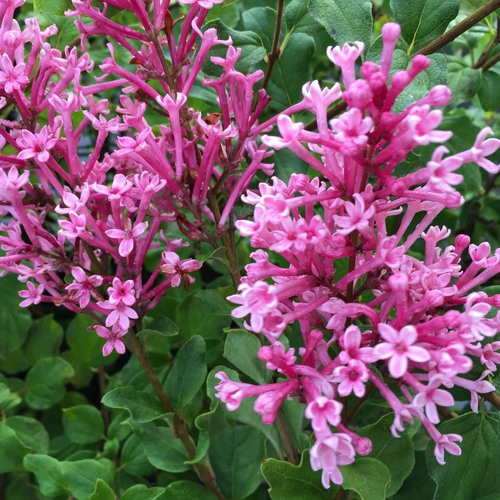| Syringa 'SMNJRPU' | USDA Zone: 3-7 |
Bloomerang Dwarf Purple Lilac naturally grows as a small, rounded shrub, at just about a third the size of conventional lilacs. It outperforms other lilacs with its perfectly purple blooms that cover the plant in late spring, then reappear throughout summer and fall.
Top reasons to grow Bloomerang® Dwarf Purple Lilac:
- Dwarf habit takes up just a fraction of the space of other lilacs
- Fragrant purple flowers for months every year
- Rarely bothered by deer or disease
Bloomerang® Dwarf Purple Lilac is recommended for the following landscape applications;
- Mass Planting
- Hedges/Screening
- General Garden Use
Companion Plants: Smoke Tree, Black-Eyed Susan, Maiden Grass, Coneflower, Juniper
Bloom Time: Spring, Summer, Fall
Fragrant Flower
Continuous Bloom or Rebloomer
Attracts Butterflies
Resists Deer
Common Name: Reblooming Lilac, Lilac
|
Key Feature
|
Light Needs | Landscape Uses |
 |
 |
|
|
|
|
| More About Bloomerang Dwarf Purple Lilac |
| Height: 2-3 ft |
Spread: 2-3 ft |
Flower Colour: Purple Shades |
|
Plant only in full sun and well-drained soil; lilacs cannot tolerate soggy, wet conditions. The rebloom of Bloomerang lilac occurs on the new growth the plant creates after its spring bloom. For the best rebloom, it's vital that the plant grows vigorously during late spring and early summer. Do this by keeping it well-watered and mulched and in plenty of sun (six hours a day at least). If you wish to fertilize it, you may do so in early spring, once the ground has thawed, and again in late spring, after it blooms. If you want to prune Bloomerang lilac, do so immediately after its spring bloom. Never cut it back in fall, winter, or early spring - doing so will remove the spring flower buds. It is not necessary to prune Bloomerang lilac in order for it to rebloom. However, giving it a light trim after blooming does remove the developing seed heads (they look like green bananas, and some people don't care for the way they look on the plant), providing a neater look, and encourages more new growth for reblooming. Trimming after blooming will delay the rebloom by a few weeks compared to an untrimmed Bloomerang lilac. Note that when grown in a container, it may not perform exactly as indicated on the tag - this is to be expected. Also note that when growing plants in outdoor containers and baskets, they may require more frequent waterings than they would in the yard or garden. Be aware that in our climate, most plants cannot be expected to survive the winter if left in containers outdoors, and this plant is no exception. NOTE: Some flowers and plants may be harmful or poisonous to people or pets if touched or ingested. If you require more information before placing an order, please let us know in advance. |












